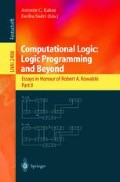Abstract
We propose statistical abduction as a first-order logical framework for representing, inferring and learning probabilistic knowledge. It semantically integrates logical abduction with a parameterized distribution over abducibles. We show that statistical abduction combined with tabulated search provides an efficient algorithm for probability computation, a Viterbi-like algorithm for finding the most likely explanation, and an EM learning algorithm (the graphical EM algorithm) for learning parameters associated with the distribution which achieve the same computational complexity as those specialized algorithms for HMMs (hidden Markov models), PCFGs (probabilistic context-free grammars) and sc-BNs (singly connected Bayesian networks).
This paper is based on a workshop paper presented at the UAI-2000 workshop on Fusion of Domain Knowledge with Data for Decision Support, Stanford, 2000.
Access this chapter
Tax calculation will be finalised at checkout
Purchases are for personal use only
Preview
Unable to display preview. Download preview PDF.
References
Bacchus, F., Using First-Order Probability Logic for the Construction of Bayesian Networks, Proc. of UAI’93, pp219–226, 1993.
Baker, J.K., Trainable Grammars for Speech Recognition, Proc. of Spring Conference of the Acoustical Society of America, pp547–550, 1979.
Breese, J.S., Construction of Belief and Decision Networks, J. of Computational Intelligence, Vol. 8 No. 4 pp624–647, 1992.
Castillo, E., Gutierrez, J.M., and Hadi, A.S., Expert Systems and Probabilistic Network Models, Springer-Verlag, 1997.
Charniak, E., A neat theory of marker passing, Proc. of AAAI’86, pp584–588, 1986.
Charniak, E., Statistical Language Learning, The MIT Press, 1993.
Clark, K., Negation as failure, In Gallaire, H., and Minker, J. (eds), Logic and Databases, pp293–322, Plenum Press, 1978.
Cormen, T.H., Leiserson, C. E. and Rivest, R.L., Introduction to Algorithms, MIT Press, 1990.
Csinger, A., Booth, K.S. and Poole, D., AI Meets Authoring: User Models for Intelligent Multimedia, Artificial Intelligence Review 8, pp447–468, 1995.
Cussens, J., Loglinear models for first-order probabilistic reasoning, Proc. of UAI’99, pp126–133, 1999.
Cussens, J., Parameter estimation in stochasitc logic programs, Machine Learning 44, pp245–271, 2001.
Dekhtyar, A.and Subrahmanian, V.S., Hybrid Probabilistic Programs, Proc. of ICLP’97, pp391–405, 1997.
Doets, K., From Logic to Logic Programming, MIT Press, Cambridge, 1994.
Eshghi, K. Abductive Planning with Event Calculus, Proc. of ILCP’88, pp562–579, 1988.
Hobbs, J.R., Stickel, M.E., Appelt, D.E. and Martin, P., Interpretation as abduction, Artificial Intelligence 63, pp69–142, 1993.
Kakas, A.C., Kowalski, R.A. and Toni, F., Abductive Logic Programming, J. Logic Computation, Vol. 2 No. 6, pp719–770, 1992.
Kakas, A.C., Kowalski, R.A. and Toni, F., The role of abduction in logic programming, Handbook of Logic in Artificial Intelligence and Logic Programming, Oxford University Press, pp235–324, 1998.
Kameya, Y. and Sato, T., Efficient EM learning with tabulation for parameterized logic programs, Proc. of CL2000, LNAI 1861, Springer-Verlag, pp269–284, 2000.
Koller, D. and Pfeffer, A., Learning probabilities for noisy first-order rules, Proc. of IJCAI’97, Nagoya, pp1316–1321, 1997.
Koller, D., McAllester, D. and Pfeffer, A., Effective Bayesian Inference for Stochastic Programs, Proc. of AAAI’97, Rhode Island, pp740–747, 1997.
Lakshmanan, L.V.S. and Sadri, F., Probabilistic Deductive Databases, Proc. of ILPS’94 pp254–268, 1994.
Manning, C. D. and Schütze, H., Foundations of Statistical Natural Language Processing, The MIT Press, 1999.
McLachlan, G. J. and Krishnan, T., The EM Algorithm and Extensions, Wiley Interscience, 1997.
Muggleton, S., Stochastic Logic Programs, in Advances in Inductive Logic Programming (Raedt, L. De ed.) OSP Press, pp254–264, 1996.
Ng, R. and Subrahmanian, V.S., Probabilistic Logic Programming, Information and Computation 101, pp150–201, 1992.
Ngo, L. and Haddawy, P., Answering Queries from Context-Sensitive Probabilistic Knowledge Bases, Theoretical Computer Science 171, pp147–177, 1997.
Nilsson, N.J., Probabilistic Logic, Artificial Intelligence 28, pp71–87, 1986.
Pearl, J., Probabilistic Reasoning in Intelligent Systems, Morgan Kaufmann, 1988.
Pfeffer, A., IBAL:A Probabilistic Programming Language, Proc. of IJCAI’01, pp733–740, 2001.
Poole, D., Goebel, R. and Aleliunas, R., Theorist: a logical reasoning system for default and diagnosis, In Cercone, N., and McCalla., eds., The Knowledge Frontier, Springer, pp331–352, 1987.
Poole, D., Probabilistic Horn abduction and Bayesian networks, Artificial Intelligence 64, pp81–129, 1993.
Rabiner, L. and Juang, B. Foundations of Speech Recognition, Prentice-Hall, 1993.
Sato, T., A Statistical Learning Method for Logic Programs with Distribution Semantics, Proc. of ICLP’95, pp715–729, 1995.
Sato, T. and Kameya, Y., PRISM:A Language for Symbolic-Statistical Modeling, Proc. of IJCAI’97, pp1330–1335, 1997.
Sato, T., Modeling Scientific Theories as PRISM Programs, ECAI Workshop on Machine Discovery, pp37–45, 1998.
Sato, T., Parameterized Logic Programs where Computing Meets Learning, Proc. of FLOPS2001, LNCS 2024, 2001, pp40–60.
Sato, T., Kameya, Y., Abe, S. and Shirai, K., Fast EM learning of a Family of PCFGs, Titech Technical Report (Dept. of CS) TR01-0006, Tokyo Institute of Technology, 2001.
Sato, T. and Kameya, Y., Parameter Learning of Logic Programs for Symbolic-statistical Modeling, submitted for publication.
Sato, T., Abe, S., Kameya, Y. and Shirai, K., A Separate-and-Learn Approach to EM Learning of PCFGs, Proc. of NLPRS2001, Tokyo, 2001.
Sakama, T. and Inoue, K., Representing Priorities in Logic Programs, Proc. of JIC-SLP’96, MIT Press, pp82–96, 1996.
Shanahan, M., Prediction is Deduction but Explanation is Abduction, Proc. of IJCAI’89, pp1055–1060, 1989.
Tamaki, H. and Sato, T., OLD resolution with tabulation, Proc. of ICLP’86, LNCS 225, pp84–98, 1986.
Wetherell, C.S., Probabilistic Languages: A Review and Some Open Questions, Computing Surveys, Vol. 12, No. 4, pp361–379, 1980.
White, H.C., An Anatomy of Kinship, Prentice-Hall INC., 1963.
Author information
Authors and Affiliations
Editor information
Editors and Affiliations
Rights and permissions
Copyright information
© 2002 Springer-Verlag Berlin Heidelberg
About this chapter
Cite this chapter
Sato, T., Kameya, Y. (2002). Statistical Abduction with Tabulation. In: Kakas, A.C., Sadri, F. (eds) Computational Logic: Logic Programming and Beyond. Lecture Notes in Computer Science(), vol 2408. Springer, Berlin, Heidelberg. https://doi.org/10.1007/3-540-45632-5_22
Download citation
DOI: https://doi.org/10.1007/3-540-45632-5_22
Published:
Publisher Name: Springer, Berlin, Heidelberg
Print ISBN: 978-3-540-43960-8
Online ISBN: 978-3-540-45632-2
eBook Packages: Springer Book Archive

